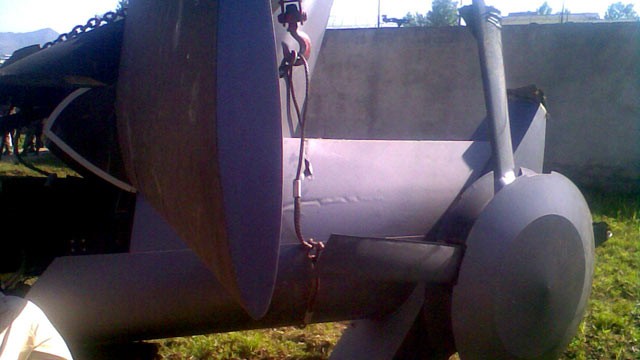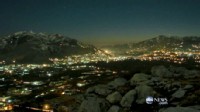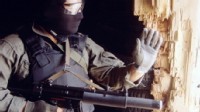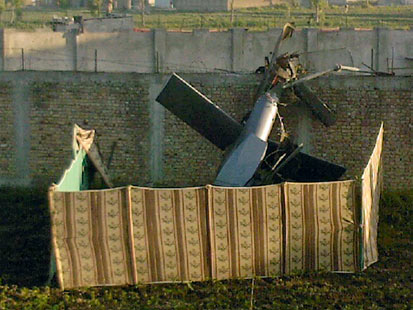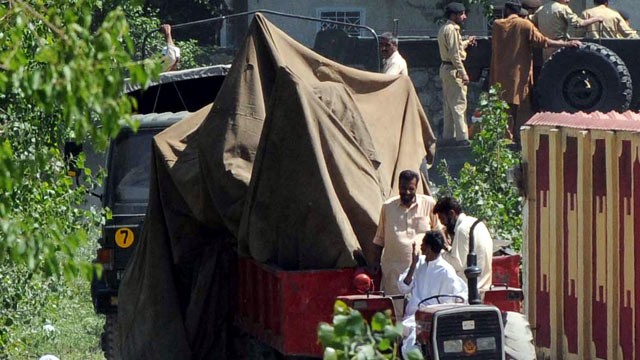At the outset of writing about the controversy surrounding Trig Palin’s birth, I said clearly that I could go either way on what to believe about this story.
On the one hand, I do see why some consider this to be possibly the greatest and most malevolent
hoax in the history of American politics.
Yet, I remain intrigued by the odd, conflicting, indeed seemingly contrived anecdotes about what is
now widely called The Wild Ride, Mrs. Palin’s allegedly reckless and lengthy return to Alaska while leaking amniotic fluid and suffering contractions unbeknownst to anyone around her in order to avoid delivering in Texas someone who might one day pick fish.
Those who believe in the hoax theory argue that pictures tell nearly the entire story. That all one has to do is look at a few photos to determine that Mrs. Palin was not pregnant.
Me? I’m a skeptic. Or maybe I’m just stupid. Although with two degrees from
Columbia University, for both of which I had to write a thesis (neither of which informs my thoughts or opinions today, even though I received A’s on them, Mrs. Palin), some might call me a notch above stupid.
Things need to be spelled out for me. I know there is someone out there who can explain away every single, niggling detail about this very strange birth story. But she doesn’t appear to want to do that.
So, I thought I’d start with the photos. And little did I know that
Professor Brad Scharlott, whose paper on the
Spiral Of Silence has got more people talking about this birth story than ever before, is actually a Photoshop expert.
Prof. Scharlott teaches both digital publishing and photojournalism at
Northern Kentucky University. And he said he’d be glad to talk me through a few of the more famous pictures.
BS: Thank you for that introduction, Laura, but let me qualify what you said. I have been teaching digital publishing since the late 1980s, and I’ve taught photojournalism for nearly a decade. So I’ve had to learn a lot about Photoshop and related programs in order to teach them to my students. I’m pretty good at “photoshopping” pictures, as that word is generally used – for example, I can put people’s heads on animals’ bodies, for laughs – but calling me an expert might be an overstatement. Still, I know enough to effectively teach digital photography and photo editing to college students.
Today I’d like to focus on a picture of Palin that appeared in the Anchorage Daily News on March 14, 2008. That was nine days after Palin announced that she was seven month pregnant, and four and half weeks before she allegedly gave birth to Trig on April 18. Here it is, as it appeared in the newspaper:
While Palin looks fairly trim in this photo, it’s hard to tell just how flat her stomach is, because the darkness of her outfit obscures details.
Here’s where an experienced digital photographer can help. It’s well-known among the pros that dark areas in a photograph can be lightened to show details that otherwise will not be apparent. Any photo-editing program can be used to adjust the brightness level of a photo like this; that includes the photo-editing programs that are bundled for free with most new computers. People reading this who want to experiment can copy the above picture to their own computer, open the picture in iPhoto (if you are using a Mac, as I am), then click on the “Edit” icon, bring up the “Adjust” panel, and finally pull the “Shadows” slider to the right. (If you don’t see the “Adjust” panel, drag a corner of the photo to make it bigger.) And while you are at it, you might also bump up the brightness and contrast sliders a bit, also.
What will your adjusted photo look like? Probably like this:
Sarah’s flat stomach is now quite apparent. Notice that neither I, nor you, dear reader (if you followed along) moved a single pixel (a “pixel” is a dot in a digital picture). And I did not use Photoshop, so no one can accuse me, in any sense, of “photoshopping” the picture.
Let me address that term, by the way. When “photoshop” is used as a verb, generally it means to deceive by adding or subtracting or altering certain elements in a picture. But using Photoshop (or any other photo editing program) to simply lighten a photo is not deceptive. So be wary of what people really mean why they use the word “photoshopped.”
LN: Okay, Brad, I’m going to play devil’s advocate for a moment. Mrs. Palin looks to be leaning back in this photo, possibly because she’s chuckling about something funny the Lt. Governor said, or because of a text on her ubiquitous phone. But seriously, one could argue she is tilted back because of the weight and force of a baby belly. Couldn’t that explain her posture?
BS: I’m glad you asked that, Laura. The photographer who took this picture apparently used a zoom lens at a long setting, thus producing a photo distortion known as pin-cushioning. Look at woman to the right in the photo; you can see that her body is bowing slightly to the left with her head skewing a bit to the right corner. In the case of Palin, the bowing makes her appear to be leaning backwards.
To get a truer sense of what Palin would have looked like if you had viewed her in that scene with your own eyes, I am going to use the “Correct Camera Distortion” feature in Photoshop Elements (the cheaper, home version of Photoshop), and basically add a bit of “barreling” to counter the effect of the pincushion distortion:
The result gives a truer sense of how those three people would have looked if viewed with your own eyes that day. And while Palin seems to be standing straighter, the alteration did not affect the flatness of her stomach, which I think tells the story.
So what do you think, Laura? Do you believe Palin can be seven months pregnant in this photo?
LN: What a great question! I know I need to buckle down and not dither, and I know that this is about health care and job creation, there, also too. But I need to ask a man and I will get back to you (as someone might say).
Seriously, Brad, can’t someone say that any change in a digital picture makes it less authentic, less true?
BS: Well, digital pictures are sometimes not admissible in court (for example, if the original is unavailable) because they are so easily manipulated. So you need to feel confident that the source of a digital picture is trustworthy. This particular picture comes from a major newspaper, so there is no reason to believe it was deceptively altered before it was posted online or published in the paper.
But the answer to your question is an emphatic “no,” altering a digital picture, say, by lightening it, does not make it less “authentic” (whatever that might mean). That’s because all digital photographs have already been processed in various ways before you see them. A cheap point-and-shoot camera makes numerous decisions for the user, such as light level and sharpness. A pro photographer using the “RAW” files captured by her camera must make those decisions herself before generating the pictures. (Back in the old days of film, any print of a picture had to likewise be processed through multiple steps, all of which introduced alterations from the “original,” which was generally a negative.)
Lightening a picture that already has been generated does not affect its “truthfulness” – it just presents a different aspect of the visual truth. The second picture above shows more detail than the
first picture, and that is truthful, because in fact a person viewing the scene would have seen those details, since the human eye is much more sensitive than a digital camera. And the third picture is just as truthful as the first (or even more so) because it removes distortion caused by optics – in particular, by a zoom lens; it’s showing the scene as it would have looked to the human eye.
So the question for readers is this: Can you imagine any way Palin in this photo might be seven months pregnant?
LN: For my part, I covered up her head with a piece of paper and tried to look at the photo that way. And I must admit I see no pregnant stomach there. What do Mrs. Palin’s supporters say about this photo? How do they explain it? Because as I’ve said all along on this blog, I am wide open to having a conversation about this.
BS: Palin supporters generally try to ignore or belittle photographic evidence. Julia O’Malley, on April 14, in an
Anchorage Daily News article with the headline “Make. It. Stop.” wrote this about my research paper titled “Palin, the Press, and the Fake Pregnancy Rumor”: “I read Scharlott's
piece. It contains lots of innuendo and some widely-circulated Photoshopped pictures. What is missing from his investigation: facts.”
Notice her use of “Photoshopped” – the implication is the photos are deceptive. But in the case of the above photo, what deception can she possibly be referring to? The picture comes from her own newspaper! If she wants, she can probably go straight to the photographer who took the picture and get a copy from his or her hard drive, just as it was downloaded from the photographer’s camera.
She wrote that my investigation lacks “facts.” (The paper has over 40 footnotes, so it’s brimming with verified, factual information.) But a photograph is also a “fact.” Can she look at the above picture and honestly say she thinks Palin might be seven months pregnant in it? In her article she wrote that Palin’s baby bump was obvious. What baby bump?
LN: Allow me to interrupt here and say that “obvious” is the last word I would use about this photo. I don’t know what the truth is, but there is no “obvious” pregnancy here.
BS: Exactly! In that same vein, I would like to invite Justin Elliot of Salon, who on April 22 wrote an article with the presumptuous headline “Trig Trutherism: The Definitive Debunker,” to exam the photographic evidence presented here. And after he examines it, I’d like to know if he still feels 100 percent sure Sarah Palin was in fact pregnant with Trig. If his answer is yes, then I’d like him to explain what he makes of this photograph.
I have a doctorate in mass communications from a top school in that field, the
University of Wisconsin-Madison, which means I’m a trained researcher. My research has been published in numerous peer-reviewed academic journals. I teach a senior-level college class on research methods. I’m an empiricist. I believe truth can be discovered and verified. And this picture that we have just examined objectively exists, and its truth value can be assessed. Here’s my bottom line from my examination of the photo: I am at least 95 percent confident that Sarah Palin is not seven months pregnant in that photo.
However, I am not 100 confident. I have no medical training. I do not work with pregnant women as a matter of course in my job. There are many people who can offer a much more authoritative reading of that photo than I can, including you, Laura, who have written so eloquently about your own high-risk pregnancy and the months your child lived in a NICU. So I am making a request, or rather several requests, of your readers:
1. Would those of you with medical training, especially if it involves working with pregnant women, let me know if you believe Sarah Palin might be seven months pregnant in the above photo? Please let me know your credentials and if I may quote you by name in a follow-up article. If you possess relevant photographic evidence, please send it.
2. Would those of you who have been pregnant at least five times let me know if you, in the seventh month of your fifth pregnancy, looked approximately as slender as Palin does in the above photo. If you could verify your stage of pregnancy (for example, with the date of the photo plus the date that you gave birth), that would be great. Let me know if I may quote you by name and print your picture in a follow-up article. Likewise, if a close relative of yours (your wife, sister, etc.) looked that slender in the seventh month of her fifth pregnancy, let me know and send a picture.
3. If you are a professional photographer who has worked with pregnant women, please share any relevant observations or photographs you might have.
Feel free to post your comments below and I will certainly read them here, and respond, on Laura’s blog. Or if you wish for more privacy concerning your name, etc., you might want to post anonymously below or email Laura on her Contact page. But send your comments plus personal information and/or pictures to me at brad.scharlott@gmail.com.
Thanks in advance for your help. And Laura, it’s always fun talking with you about this story, journalist-to-journalist.
LN: Thank you, Brad. And I know that we are going to analyze two more critical photos here on my blog. And I can’t wait to see what you’ve got!











